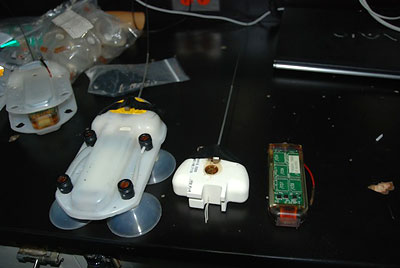

 | |||||||||
|
|
Journals 2008/2009Megan O'Neill
May 15, 2009 The ship reached our destination of Andvord Bay in the night, and after the sun rose at 8:45 a.m., we could see the stunning scenery around us. I have yet to cease to be impressed by the massive cliffs of rock and glaciers that drop straight to the water. Some commented that it looked similar to Eletta's home territory around Lake Coumo, Italy. The whale team got their equipment ready and tested the VHF antennas on the bridge. They were going to be ready to get out in the Zodiacs as soon as the wind subsided enough to get them on the water. There are essentially three groups of scientists with the whale efforts that have to coordinate as a team to accomplish this mission. The first team consists of the observers: Dave, Andy, Eletta, Reny and Lindsey. They are responsible for doing surveys of the wildlife noted in the area. The system for doing this is very methodical. First of all they rotate in four 34-minute shifts to different stations on the bridge: Starboard Observer, Port Observer, Data Recorder and break. This keeps them from getting glazed over while scanning the waters for the whale sightings. They also note environmental conditions in the computer log that may affect their success with sightings. The second group of scientists consists of the Tag Team - Ari, Allison and Doug. Doug actually helped the designers of the tag that is used. There are only 12 of this type of tag in existence, and the three we have will be used for projects in Cape Cod following this trip. The tag consists of plastic housing box that is about eight inches in length with a metal antenna and four suction cups on the bottom to attach to the whale. The tag records pitch, roll, acceleration, heading, depth, and audio 50 times per second and the audio is 96kHz. The tag can be set to a time to be released or can be released after a certain amount of time. The way that it is released from the animal is by wires burning behind the suction cups that cause them to detach. The third team consists of Mapping, Visualizing Data and Krill - Yiwu, Meng, Elliott, Pat, Boris, Collin and Roland. Today I have been assisting the Observer team on the bridge to get a feel for the process. After the fog lifted and the sun began to come out of the clouds at about 11 a.m. and about 4-5 whales were observed, the Zodiacs were placed in the water. Ari, Allison, Boris and Julie were in the tag boat and Dan, Pat and Elliott were in the prey tracking boat. The prey tracking boat has a neat cover in the center of the boat that helps to protect their computer gear from the water. They had an approach within the first thirty minutes with a whale and got within 45 meters, at which time the whale decided to show its fluke and take a dive - BUMMER! Opportunity missed! So, they continued after another set of three whales that were doing a lot of "social movement" - head up out of the water (when the eye actually emerges it is called "spy hopping"), flippers waving out of the water and breeching. These movements were definitely going to make a tag placement difficult. The tag boat followed the whales for a while and did not get a good shot. The tag is actually placed on the animal by someone placing the tag on the end of a long pole and then pressing the tag suction cups with enough force to get them to stick. In order to be able to place the tag on the whale, the boat has to be within about six meters (about 15-20 feet). As you can imagine, it is a difficult process that can have frustrating results. I liken it to "fishing" in that it is not always "catching," the difference being you can actually see your "fish" unlike fishing. The winds from the north began to pick up and the Zodiacs were brought back onboard. At about 2:45, as dusk was approaching and we had headed farther into the cove, we started to see more whales. The wind was much more cooperative and was only at about 8 knots. Ari decided to get the Zodiacs back into the water and go for another attempt. Doug, Ari and Julie headed off after a whale that was very near the stern. We watched from the bridge and with the binoculars had a perfect view. They got right up next to a pair of whales, Ari reached out with the tag on the end of the pole and placed the tag on the larger of the two. PERFECT! Made it look easy! Everyone celebrated and began listening to the beeps emitted from the tags each time the whale surfaced. A few minutes passed and then the beeps began to be non-stop even though the whale was under the water. This was not the result the scientists wanted because it indicated the tag had come off of the whale - Tag On! And Tag Off! This was disappointing because the goal was to leave the tag on overnight and follow the whale during their more active feeding when the krill come up closer to the surface. The tag team located the tag, followed the pair of whales for a while longer until the lack of light became an issue and returned to the ship. We are hoping for better luck tomorrow!
|
||||||||
